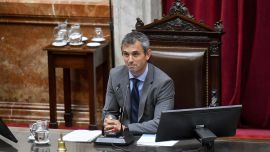Between the end of this month and the beginning of September, Economy Minister Sergio Massa will be paying a visit to the United States to renegotiate with the International Monetary Fund (IMF) the debt conditions which the government signed in March.
Last month’s fiscal data yielded a fiscal deficit close to 3.2 percent of Gross Domestic Product. To reach the target figure of US$8.125 billion of net reserves established in the agreement with the IMF from the US$2.325 billion of March, the Central Bank would have to buy a further US$5.8 billion by December, something which hardly seems feasible.
But the debt to the IMF is not the Argentine state’s biggest. According to the latest data published by the Finance Secretariat to which Perfil had access, that was US$43.308 billion last month, well below the peso debt which (when adjusted to inflation) reached US$55.141 billion.
The report also gave last month’s gross debt in a normal situation of payment as US$378.307 billion as against the US$342.56 billion of the same month last year when Martín Guzmán was economy minister.
In other words, debt has grown by a monthly average of US$2.978 billion in the last 12 months.
Just between June and July, debt increased by the equivalent of US$2.262 billion, representing monthly growth of 0.6 percent.
The variation is explained by a reduction of US$2.248 billion of debt in foreign currency and an increase of “peso” debt of US$4.51 billion in its dollar equivalent.
Controversy
The debt issue in pesos as opposed to dollars has triggered more than one controversy since Massa became economy minister.
Former productive development minister Matías Kulfas aimed his fire at former Economy Minister Nicolás Dujovne and former Central Bank governor Guido Sandleris when he affirmed: “It is perhaps too late to understand the rock-bottom handling of the public debt left by the Mauricio Macri government.” Both men were officials in ex-president Macri’s 2015-2019 administration.
Kulfas, via his Twitter account, highlighted: “Peso debt is not the same thing as dollar debt. Debt between public sectors is not the same thing as foreign debt to the IMF,” adding: “Any ordinary citizen can understand perfectly well the difference between peso and dollar debt. It’s like going into debt with your wife, husband or brother versus going into debt with a bank. The only people who do not understand that difference are the economists of Juntos por el Cambio.”
The reply of Sandleris ran: “If you owe 20 to your brother and 20 to the bank and only recognise the latter, apart from shitting on your brother, you’re a liar.”
In any event last month’s debt of US$378.307 billion is US$58 billion above the US$320.525 billion left by the Macri government at the end of 2019 despite the debt swap with private creditors concluded in September, 2020, the renewal of the loan of US$44.8 billion from the IMF last March and deferment of payments to the Paris Club of US$2.4 billion until 2024.
Meanwhile, former finance secretary Miguel Kiguel has warned against snowballing Leliq debt as part of a quasi-fiscal deficit which was quantified at seven trillion pesos by the Central Bank on August 11 with private consultants estimating monthly interest payments at over 400 billion pesos.
by Fabián Quintá, Perfil





















Comments